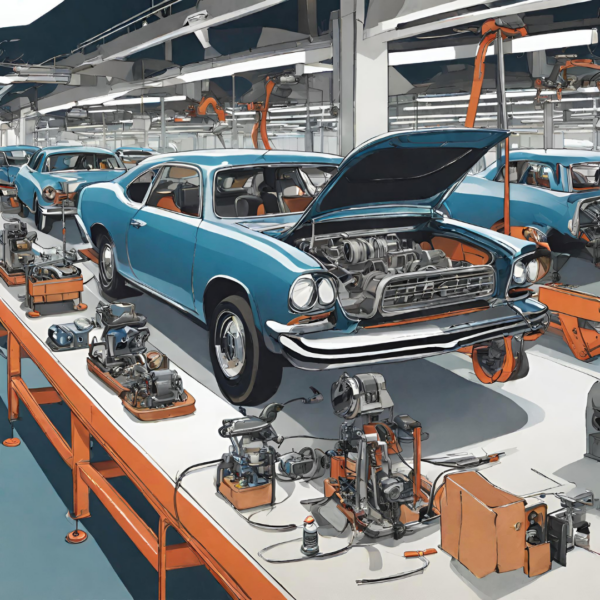Force Measurement and Load Cell Precision Can Drive Auto Innovation
In automotive design and engineering, precision isn't just a buzzword—it's the foundation that ensures safety, performance, and reliability.
At the core of this precision are force measurement and load cells, the dynamic duo that keeps the automotive industry racing ahead. These crucial tools not only gauge the finesse of each component but also ensure that every aspect of a vehicle, from the torque in the engine to the balance in the suspension, is meticulously fine-tuned. This beats having a recall because somebody had an improper measurement, the wrong equipment, or a process issue like not using the same adapters used for calibration.
Force measurement and load cells play a critical role in the automotive industry.

Why Load Cells and Force Measurement Are Game-Changers for Cars
Imagine engineering a car that handles every curve gracefully, stops swiftly when danger looms, and stays sturdy through years of journeys. That's where force measurement and load cells emerge, serving as the industry's yardsticks for precision and safety.
Crash Testing: Force measurement is crucial for simulating and analyzing the impact forces during crash tests. It helps assess the safety and performance of vehicle components, such as airbags, seatbelts, and crumple zones.

Structural Integrity: Automakers use force measurement to evaluate the structural integrity of vehicle components and materials. This includes assessing the strength and durability of chassis, suspension systems, and various vehicle parts.
Quality Control: Force measurement is used in quality control processes to ensure that components, such as bolts, fasteners, and welds, are tightened to the correct torque specifications. This is vital for vehicle safety and reliability.
Suspension and Steering Systems: Force measurement helps optimize the design and performance of suspension and steering systems, ensuring smooth and responsive handling.
Brake Systems: Force measurement is critical for evaluating the performance of braking systems, including measuring brake pedal force and the effectiveness of brake components like brake pads and discs.
Tire Testing: Tire manufacturers use force measurement to assess tire performance, including factors like rolling resistance, tread wear, and road grip.
Powertrain Development: Force measurement is employed to develop and test components, including engines and transmissions. It helps optimize efficiency and performance.
Noise, Vibration, and Harshness (NVH) Testing: Force measurement aids in analyzing the forces and vibrations that affect vehicle comfort and noise levels. This is important for refining the driving experience.
Crash Avoidance Systems: Force measurement is used to develop and test advanced driver-assistance systems (ADAS), which rely on precise force data to make real-time collision avoidance and safety decisions.
Occupant Safety: Force measurement contributes to the design and testing of safety systems within the vehicle, such as seatbelts, airbags, and child restraint systems.
Material Testing: The automotive industry uses force measurement to evaluate the mechanical properties of materials, ensuring they meet safety and performance standards.
R&D and Prototyping: Automotive manufacturers and suppliers rely on force measurement for research, development, and prototyping to create innovative vehicle features and components.
Force measurement is a fundamental aspect of automotive engineering and manufacturing. It helps ensure vehicle safety, reliability, and performance and contributes to vehicle technology and design advancements.
Driving this innovation in the automotive industry means having the right requirements, equipment, and processes. Knowing the right requirements, purchasing the right equipment, and having the proper process can reduce measurement risks.
The right requirements might mean adhering to a ratio of uncertainty to accuracy where the uncertainties are at least five times better than what is being measured. The ratio is critical to limiting the overall measurement risk. The higher the ratio, the less chance of saying something is good when it is bad or bad when it is good. For example, a 5:1 ratio typically controls these risks to less than 2 %.
To get these types of uncertainties typically requires deadweight calibrations. If the specification is 0.1 percent, the equipment used to make the measurement should have a measurement uncertainty greater than 0.02 percent (five times better than 0.1). These ratios need to be determined based on controlling the risk. The rules of metrological traceability say that you can have a measurement uncertainty better than that of the reference lab used to perform the calibration. Hence, if 0.02 percent is what you need to work to, you will likely need a lab with measurement uncertainties of better than 0.01; ideally, that number might be better than 0.004 %.
Not all tools are created equal, and automotive companies must use the right equipment. Using the right equipment can lead to accurate measurements and more significant problems. So, always ensure that your equipment suits the task at hand.
To be successful, automotive companies must have the right processes. This rule requires a training program and proof of training (records) to validate the individuals calibrating or using the equipment. A process should be in place that ensures all aspects of the standards are being carefully satisfied in the calibration process. Use proper adapters and ensure the instrument's calibration matches its use in the field or lab.
Tuning Up Load Cells for Peak Performance
But just like a high-performance engine, load cells, and force measurement systems need regular maintenance to deliver accurate results. Various factors, from the daily grind on the production line to the precision required in testing labs, can affect their performance. To keep these instruments in check, regular calibration is crucial.
According to our insights, we need a significant number of flawless calibrations (meeting the accuracy requirement year to year) for a 95 % Reliability Target at a Confidence Level of 95 %. This shows how essential meticulous attention to detail is in the automotive sector.
Revving Up Reliability in Automotive Testing
Maintaining the reliability of force measurement and load cells is a multi-layered task:
Routine Maintenance: Regular check-ups are the first line of defense in ensuring that every measurement and test reflects true precision.
Quality Instruments: Investing in high-quality load cells and measurement devices pays off in the long run, reducing errors and enhancing safety.
Expert Handling: Skilled technicians who understand the intricacies of these tools are invaluable. Training is essential to keep them adept at spotting and troubleshooting potential inconsistencies.
Constant Monitoring: Tools like load cell simulators help keep a vigilant eye on performance, ensuring that the data from these devices remains consistent and reliable.
The automotive industry's quest for perfection is ceaseless. As vehicles become more complex and consumer expectations rise, tools like load cells become central to maintaining a brand's reputation for precision, safety, and trustworthiness. By understanding their importance and ensuring their optimal operation, manufacturers can solidify their commitment to delivering the best to the roads.
Read more on this here.
About Morehouse Instrument Company
Companies worldwide rely on Morehouse for accuracy and speed. The company turns around equipment in 7-10 business days so customers can return to work quickly and save money.
The York, PA-based company provides force and torque measurement products and services worldwide.
Morehouse Instrument Company, a trusted and accredited provider of force and torque measurement services for over 100 years, offers measurement uncertainties 10-50 times lower than the competition.
Morehouse helps commercial labs, government labs, and other organizations lower their measurement risk by lowering equipment uncertainties for torque and force measurement. Contact Morehouse at info@mhforce.com .
More Information about Morehouse
We believe in changing how people think about force and torque calibration in everything we do.
This includes setting expectations on load cell reliability and challenging the "just calibrate it" mentality by educating our customers on what matters and what causes significant errors.
We focus on reducing these errors and making our products simple and user-friendly.
This means your instruments will pass calibration more often and produce more precise measurements, giving you the confidence to focus on your business.
Companies around the globe rely on Morehouse for accuracy and speed.
Our measurement uncertainties are 10-50 times lower than the competition.
We turn around your equipment in 7-10 business days so you can return to work quickly, saving you money.
When you choose Morehouse, you're not just paying for a calibration service or a load cell.
You're investing in peace of mind, knowing your equipment is calibrated accurately and on time.
Contact Morehouse at info@mhforce.com to learn more about our calibration services and load cell products.
Email us if you ever want to chat or have questions about a blog.
We love talking about this stuff.
Our YouTube channel has videos on various force and torque calibration topics here.


